Network As A Service Market Size and Share
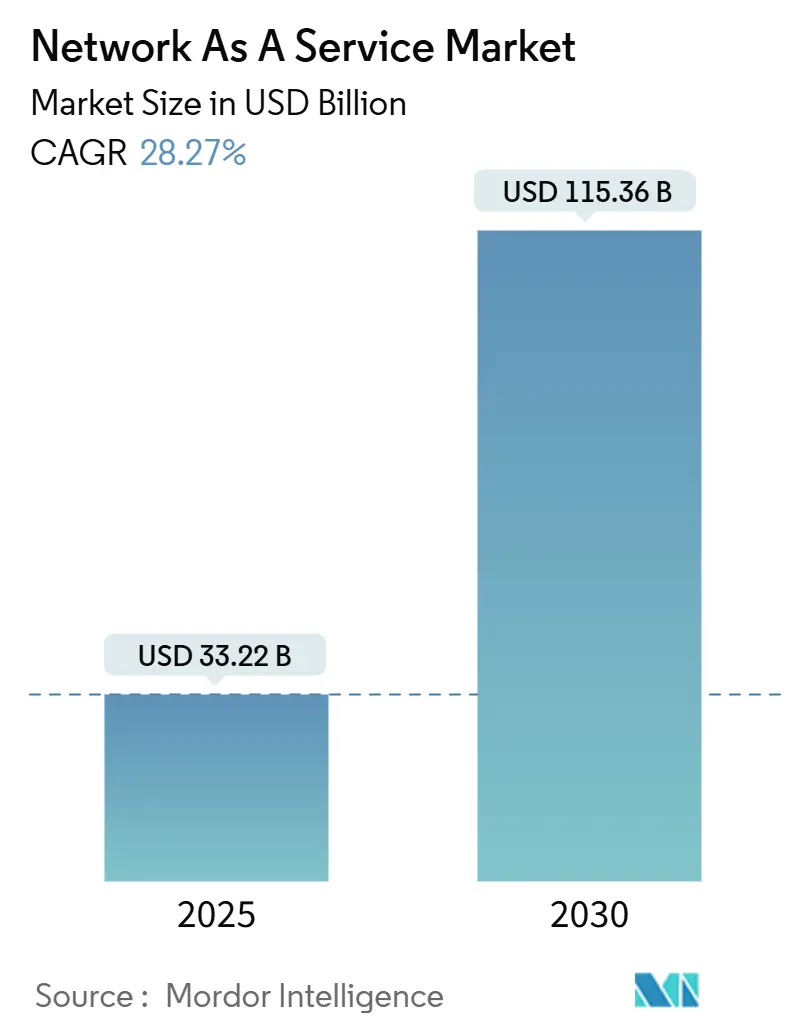
Network As A Service Market Analysis by Mordor Intelligence
The Network as a Service market size is valued at USD 33.22 billion in 2025 and is forecast to reach USD 115.36 billion in 2030, registering a 28.3% CAGR over the period. This expansion reflects a decisive enterprise shift from capital-intensive hardware ownership toward consumption-based service models that align operating budgets with agility needs. Strong momentum comes from cloud-first transformation roadmaps, rapid SD-WAN and SASE rollouts, and AI-driven network-assurance engines that cut mean time to repair to under five minutes[1]Cisco Newsroom, “Cisco and NVIDIA Accelerate the Next Generation of Ethernet AI Networks,” cisco.com. North America retains primacy through robust enterprise digitalization and a mature managed-services ecosystem, while Asia-Pacific posts the fastest growth, supported by large-scale modernization programs and strict data-sovereignty mandates. Competitive intensity is rising as legacy equipment vendors reposition around service portfolios and telecom carriers monetize private-5G slicing. At the same time, data-residency rules, vendor-lock-in anxieties, and IFRS 16/ASC 842 accounting complexity temper near-term adoption prospects.
Key Report Takeaways
- By service type, WAN-as-a-Service led with 45.5% revenue share in 2024, while Campus-Switch-as-a-Service is projected to advance at a 29.8% CAGR through 2030.
- By application, virtual CPE captured 42.8% revenue share in 2024, whereas integrated network-security-as-a-service is slated to grow at a 29.3% CAGR to 2030.
- By organization size, large enterprises accounted for 71.2% revenue share in 2024, while small and medium enterprises are progressing at a 30.1% CAGR to 2030.
- By industry vertical, IT and Telecom commanded 24.7% of the Network as a Service market size in 2024; manufacturing is advancing at a 28.5% CAGR through 2030.
- By geography, North America held 35.4% of the Network as a Service market share in 2024; Asia-Pacific is forecast to expand at a 28.9% CAGR through 2030.
Global Network As A Service Market Trends and Insights
Drivers Impact Analysis
| Driver | (~) % Impact on CAGR Forecast | Geographic Relevance | Impact Timeline |
|---|---|---|---|
| Cloud-first network-transformation roadmaps | +6.2% | Global; strongest in North America and EU | Medium term (2-4 years) |
| Shift from CapEx to OpEx budgeting | +5.8% | Global; pronounced in APAC and North America | Short term (≤2 years) |
| SD-WAN and SASE convergence | +4.9% | North America and EU core, spill-over to APAC | Medium term (2-4 years) |
| Campus-LAN NaaS addressing Wi-Fi 7 power spikes | +3.7% | Global; early uptake in North America and EU | Short term (≤2 years) |
| AI-driven network assurance | +4.1% | Global; led by metro enterprise hubs | Long term (≥4 years) |
| Private-5G network slicing as a service | +3.6% | APAC core, expanding to North America and EU | Long term (≥4 years) |
| Source: Mordor Intelligence | |||
Enterprises’ “cloud-first” network-transformation roadmaps
Modernization programs are redefining infrastructure consumption as organizations retire legacy hardware in favor of cloud-native, software-defined platforms that deliver intent-based automation and integrated security. Cisco notes that 91% of technology executives have boosted networking budgets to underpin AI and IoT workloads, with unified NaaS frameworks emerging as the preferred path to rapid innovation. Tight coupling of connectivity, security, and observability under a single operational model enables quicker provisioning, lower downtime, and consistent policy enforcement across multi-cloud estates. The resulting agility strengthens the Network as a Service market by turning networking into an elastic utility rather than a depreciating asset.
Shift from CapEx to OpEx subscription budgeting pressure
IFRS 16 and ASC 842 compel enterprises to recognize leases on balance sheets, complicating traditional hardware-procurement economics. Consumption-based networking helps firms sidestep large capital allocations, smooth cash-flow profiles, and shorten refresh cycles, driving uptake among CFO-led transformation initiatives. Predictable monthly spend also reduces financial risk when technology lifecycles accelerate, making subscription models especially attractive for mid-market adopters.
SD-WAN and SASE convergence accelerating managed WAN refresh
Broadcom’s VeloCloud platform combines SD-WAN with integrated security services, illustrating the pull toward single-vendor stacks that collapse networking and security into a unified fabric[2]Broadcom Inc., “VeloCloud Delivers Comprehensive SASE Platform,” broadcom.com. Enterprises gain line-rate encryption, dynamic path selection, and zero-trust enforcement without stitching together multiple point solutions, fueling refresh cycles across global branch networks. This convergence strengthens the Network as a Service market because service providers can bundle connectivity, security, and analytics into outcome-based SLAs.
Campus-LAN NaaS demand to counter Wi-Fi 7 power spikes
Wi-Fi 7’s 320 MHz channels and multi-link operation push power and cooling loads beyond facility constraints. Managed campus services allow enterprises to adopt the new standard without upfront switch upgrades or specialized RF optimization skills. Service partners spread infrastructure costs over larger fleets and apply AI-ops to maintain performance, keeping operating expenses predictable while delivering next-generation throughput.
Restraints Impact Analysis
| Restraint | (~) % Impact on CAGR Forecast | Geographic Relevance | Impact Timeline |
|---|---|---|---|
| Data-sovereignty and residency compliance barriers | -3.8% | Global; acute in EU and APAC | Long term (≥4 years) |
| Vendor lock-in around proprietary platforms | -2.9% | Global; strongest among large enterprises | Medium term (2-4 years) |
| IFRS 16/ASC 842 lease-accounting complexity | -1.7% | Global; concentrated in listed companies | Short term (≤2 years) |
| Edge-site power-cost volatility affecting TCO | -2.1% | Global; pronounced in high-energy-cost regions | Medium term (2-4 years) |
| Source: Mordor Intelligence | |||
Persistent data-sovereignty and residency compliance barriers
Regional mandates such as the European Data Act and China’s cybersecurity law require local processing and impose cross-border transfer restrictions. These frameworks complicate global service uniformity, forcing providers to deploy fragmented footprints that dilute economies of scale and extend procurement cycles, thereby slowing the Network as a Service market in regulated sectors.
Vendor lock-in fears around proprietary lifecycle platforms
Enterprises worry that tightly integrated NaaS stacks could inhibit future migration or multicloud strategies. Broadcom’s shift of VMware customers toward subscription bundles sparked debate over long-term negotiating leverage. Demand for open APIs and standards-based orchestration is rising, yet comprehensive turnkey offerings still dominate purchase decisions, creating tension between efficiency and independence.
Segment Analysis
By Service Type: WAN transformation leads while campus services accelerate
The Network as a Service market size for WAN-as-a-Service reached USD 15.10 billion in 2024 and accounted for 45.5% of revenue. Enterprises prioritize resilient, application-aware connectivity that supports hybrid work and cloud adoption. Campus-Switch-as-a-Service, however, is forecast to expand at 29.8% CAGR to 2030, propelled by Wi-Fi 7 rollouts that demand sophisticated power-management and RF optimization.
Vendors bundle switching, access points, and assurance software into subscription contracts, flattening the procurement barrier for mid-sized campuses. Over the forecast horizon, LAN-as-a-Service and data-center interconnect offerings are expected to gain share as organizations converge campus, WAN, and cloud fabrics under unified contracts. The push toward single-platform operations will keep service-type diversification at the forefront of Network as a Service market expansion.
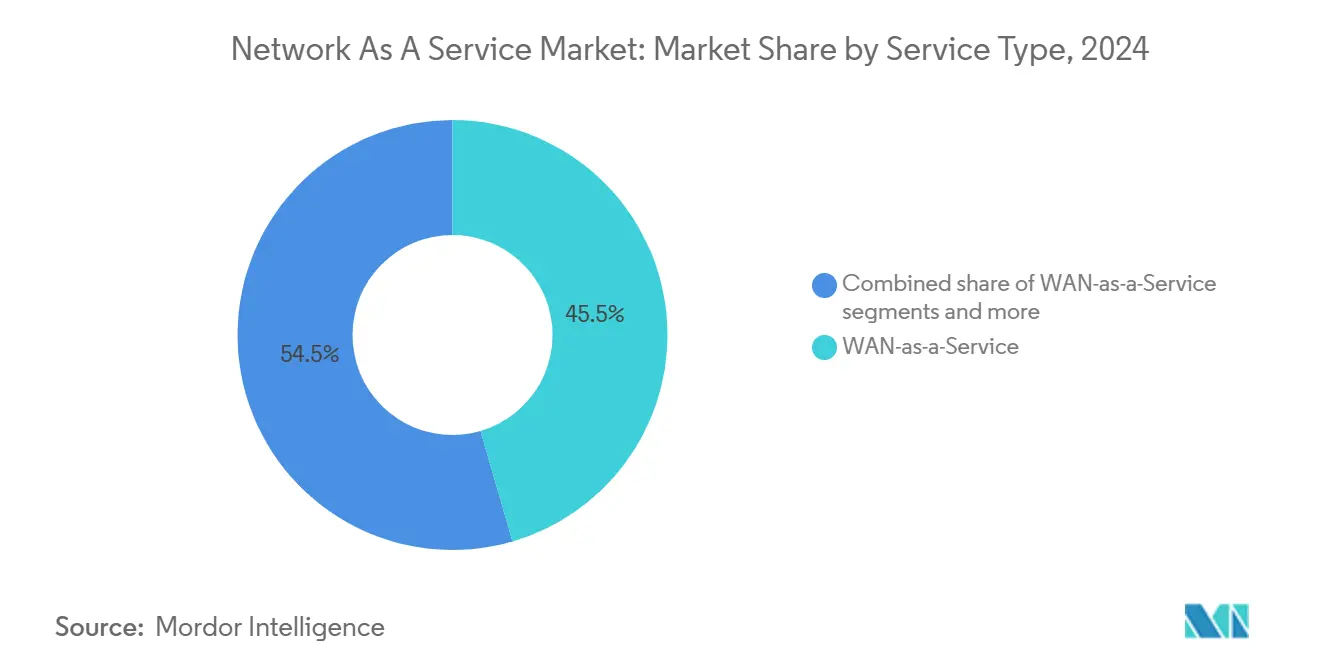
Note: Segment shares of all individual segments available upon report purchase
By Application: Virtual CPE dominance gives way to security-integrated services
Virtual CPE held 42.8% share in 2024 as enterprises replaced hardware routers with software images hosted on white-box devices. Integrated network-security-as-a-service exhibits the strongest trajectory with a 29.3% CAGR, reflecting growing reliance on SASE frameworks that blend connectivity and threat defense.
Bandwidth-on-Demand and managed VPN remain complementary, enabling dynamic capacity scaling for seasonal workloads and secure connectivity to low-bandwidth sites. By 2030, integrated security is expected to overtake virtual CPE as enterprises regard secure connectivity as baseline. The trend underpins steady increases in Network as a Service market size, channeling spend toward multi-function service tiers that bake compliance, DDoS protection, and observability into a single SLA.
By Organization Size: Enterprise accounts dominate but SME uptake accelerates
Large enterprises represented 71.2% of 2024 revenue due to complex global footprints and rigorous compliance needs that favor outsourced operations. The segment nevertheless shows steady, not explosive, growth as many Fortune 500 organizations already run proof-of-concept deployments.
In contrast, SME adoption is forecast to rise at 30.1% CAGR, supported by turnkey service catalogs that hide network complexity. Expereo’s cloud-native NaaS offering, for example, bundles internet, SD-WAN, and SASE into a per-site fee, enabling mid-market customers to achieve enterprise-grade resiliency without internal specialists. This democratization is broadening the Network as a Service market by expanding the addressable base well beyond global multinationals.
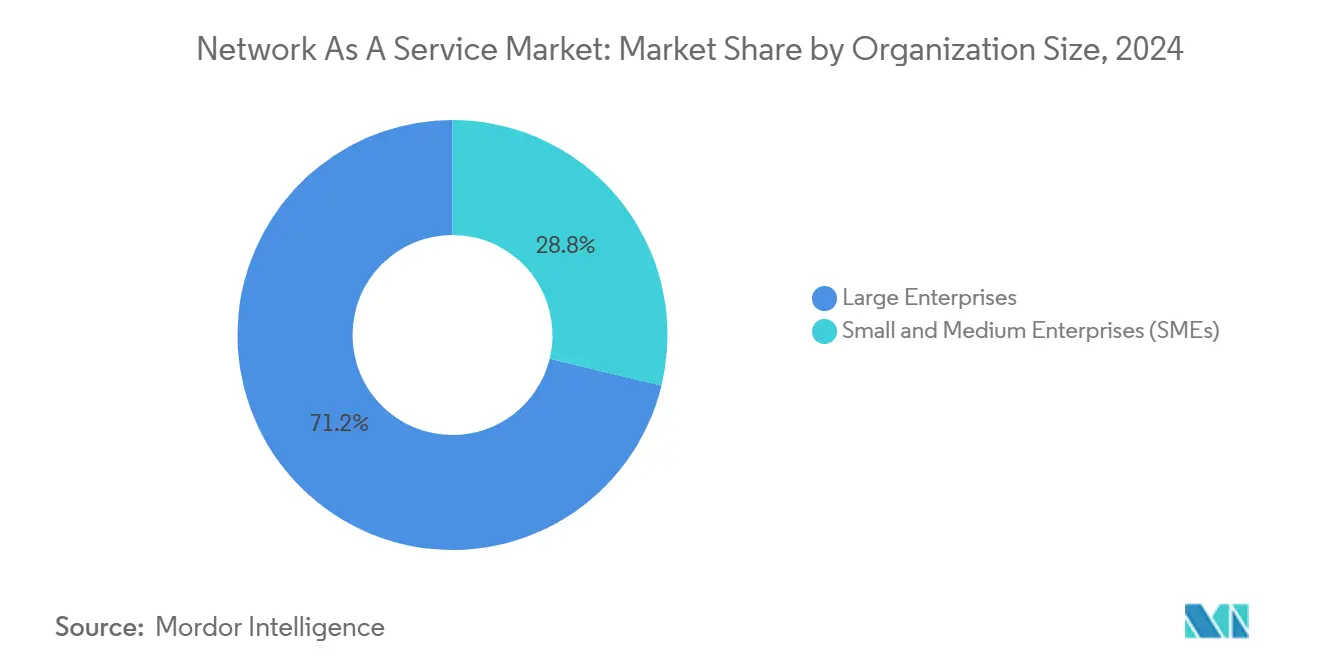
By Industry Vertical: Telecom leadership with manufacturing surge
IT and Telecom captured 24.7% revenue in 2024 by leveraging NaaS to launch new customer-facing services and streamline internal operations. Manufacturing is the fastest mover, posting a 28.5% CAGR, as Industry 4.0 initiatives require deterministic networking for robotics, machine vision, and predictive maintenance[3]Ericsson, “Industry 4.0 Drives 5G Private Networks,” ericsson.com. Healthcare, retail, and BFSI sectors also demonstrate strong pipelines, driven by telemedicine, omnichannel commerce, and digital-banking imperatives. Vertically optimized service bundles—such as low-latency fabrics for factory automation or HIPAA-compliant connectivity for hospitals—will sustain diverse revenue streams and augment Network as a Service market share for providers that cultivate sector expertise.
Geography Analysis
North America held the lion’s share at 35.4% in 2024, reflecting a sophisticated cloud ecosystem, early SASE adoption, and an active MandA landscape that consolidates capabilities within incumbent vendors. HPE’s planned USD 14 billion acquisition of Juniper Networks intends to double networking revenue contribution, signaling a platform play to challenge Cisco’s dominance. Federal and state data-privacy rules further spur managed-service uptake by enterprises that lack compliance resources in-house.
Asia-Pacific is poised for a 28.9% CAGR through 2030 as governments fund digital-infrastructure build-outs and telcos commercialize private-5G slicing for industrial campuses. China’s data-localization mandates encourage sovereign-cloud NaaS models, while India’s Production-Linked Incentive program stimulates factory digitization, together bolstering regional demand.
Europe remains opportunity-rich despite tight regulations; the upcoming Digital Operational Resilience Act drives banks and insurers toward managed connectivity that embeds audit-ready reporting. Service providers tailor offerings to satisfy GDPR, data-act portability, and emerging cyber-resilience benchmarks, promoting steady uptake. Latin America, the Middle East, and Africa are still nascent but gaining traction as cloud-service availability rises and energy-price volatility increases appetite for predictable OpEx consumption models.
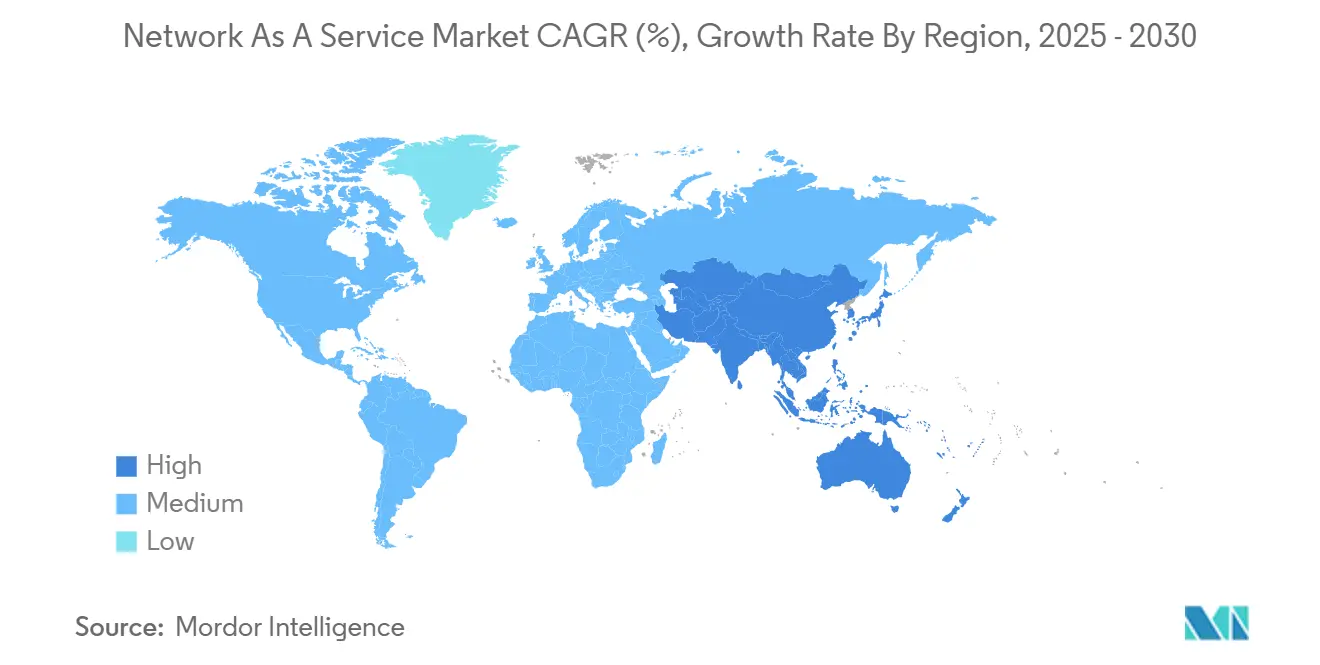
Competitive Landscape
Competition is moderate but intensifying as equipment makers, telcos, and hyperscalers converge on platform-centric value propositions. Cisco defends its share through AI-powered assurance and integrated SASE, recently partnering with NVIDIA to simplify AI-ready data-center fabrics. HPE’s Juniper bid would nearly triple its serviceable networking base, while Broadcom leverages VMware to bundle cloud-network services with compute and storage.
Telecom carriers such as NTT and T-Mobile differentiate via private-5G slicing and edge computing insertion points. Start-ups inject fresh ideas: Alkira raised USD 184 million to build multi-cloud NaaS overlays, Highway 9 unveiled mobile-cloud fabrics, and Meter secured USD 35 million to offer “AWS-like” on-prem networking. Providers strive to integrate AI-ops, zero-trust, and flexible consumption terms, but concerns regarding proprietary lock-in energize interest in open-API frameworks championed by MEF and TM Forum.
Network As A Service Industry Leaders
-
DXC Technology Company
-
Cisco Systems Inc.
-
AT&T Intellectual Property
-
Verizon
-
TD SYNNEX Corporation
- *Disclaimer: Major Players sorted in no particular order
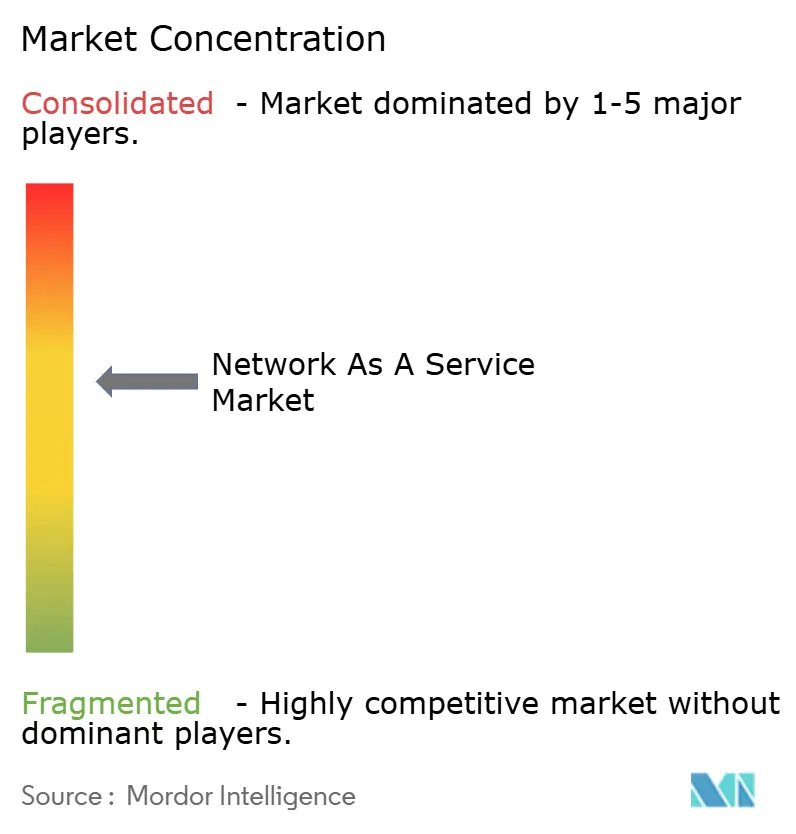
Recent Industry Developments
- April 2025: Lumen teamed with Google Cloud to fuse Cloud WAN with 400 Gbps long-haul fiber, giving enterprises direct connectivity to 50,000 sites.
- April 2025: Comcast Business finalized the acquisition of Nitel, expanding managed NaaS capabilities in finance and healthcare.
- March 2025: DigitalBridge’s Zayo unit agreed to buy Crown Castle’s Fiber Solutions arm for USD 4.25 billion, adding 90,000 route-miles to meet AI and cloud traffic growth.
- February 2025: Cisco and NVIDIA unveiled a joint AI-ready data-center architecture combining Silicon One with Spectrum-X switching.
Research Methodology Framework and Report Scope
Market Definitions and Key Coverage
Our study defines the Network as a Service (NaaS) market as the subscription-based delivery of LAN, WAN, campus-switch, and data-center-interconnect functions through software-defined networks that enterprises access on demand and pay for as they consume the service. Values capture recurring service fees, orchestration charges, and bundled managed support generated worldwide from large enterprises and SMEs.
Scope exclusion: we purposely leave out pure hardware resale, one-off professional services, and self-hosted SD-WAN appliances.
Segmentation Overview
- By Type
- LAN-as-a-Service
- WAN-as-a-Service
- Campus-Switch-as-a-Service
- Data-Centre-Interconnect-as-a-Service
- By Application
- Virtual CPE (vCPE)
- Bandwidth-on-Demand (BoD)
- Integrated Network-Security-as-a-Service
- Virtual Private Network (VPN)
- By Organisation Size
- Large Enterprises
- Small and Medium Enterprises (SMEs)
- By Industry Vertical
- IT and Telecom
- BFSI
- Healthcare
- Manufacturing
- Retail and E-commerce
- Other Industry Verticals
- By Geography
- North America
- United States
- Canada
- Mexico
- Europe
- Germany
- United Kingdom
- France
- Italy
- Spain
- Rest of Europe
- Asia-Pacific
- China
- Japan
- India
- South Korea
- Australia
- Rest of Asia-Pacific
- South America
- Brazil
- Argentina
- Rest of South America
- Middle East and Africa
- Middle East
- Saudi Arabia
- United Arab Emirates
- Turkey
- Rest of Middle East
- Africa
- South Africa
- Egypt
- Nigeria
- Rest of Africa
- Middle East
- North America
Detailed Research Methodology and Data Validation
Primary Research
Our analysts then spoke with network architects at cloud-first enterprises, procurement leads at regional carriers, and channel partners across North America, Europe, and Asia-Pacific. Conversations clarified per-site bandwidth budgets, SD-WAN refresh timing, and the likely shift toward integrated SASE bundles, thereby refining assumptions drawn from secondary work.
Desk Research
We began with tier-1 public indicators such as International Telecommunications Union fixed-broadband lines, Eurostat cloud-adoption tables, US Census ICT spending, and OECD enterprise counts, which set the demand canvas. Carrier 10-Ks, regulator tariff sheets, and investor presentations sharpened average service pricing, while premium sets like Dow Jones Factiva news feeds and D&B Hoovers financials confirmed supplier revenue splits. These and many additional references formed the factual spine before interviews commenced.
Market-Sizing & Forecasting
A top-down addressable spend reconstruction scales enterprise ICT budgets by NaaS penetration rates gathered via interviews and is cross-checked with sampled average selling price multiplied by active site counts from supplier disclosures to anchor the bottom-up sense check. Key variables include branch digitization rates, managed SD-WAN line counts, cloud-workload migration shares, provider churn ratios, and regional currency trends. Multivariate regression supported by ARIMA smoothing projects each driver through 2030, and where data are sparse, we interpolate using the closest trade association proxy.
Data Validation & Update Cycle
Model outputs pass dual peer review, variance screening against carrier service revenues, and anomaly checks. Any material deviation prompts re-contact with earlier respondents. Mordor refreshes the dataset every twelve months, with interim updates when mergers, pricing moves, or new regulations materially shift the outlook.
Why Mordor's Network As A Service Baseline Stands Firm
Published estimates vary because firms choose different service baskets, base years, and update rhythms.
Gaps typically stem from reliance on vendor revenue roll-ups that overlook campus-switch as a service or use of 2022 baselines that ignore the recent surge in demand. Mordor covers the full service stack and updates annually, so currency rebasing and rapid SASE bundling shifts are captured promptly.
Benchmark comparison
| Market Size | Anonymized source | Primary gap driver |
|---|---|---|
| USD 33.22 B (2025) | Mordor Intelligence | - |
| USD 32.53 B (2025) | Global Consultancy A | Limited primary validation; five-year refresh cadence |
| USD 13.20 B (2022) | Industry Journal B | Older base year; excludes LAN and campus services; vendor revenue roll-ups only |
The comparison shows that, although headline numbers differ, Mordor's disciplined scope choices, yearly recalibration, and blend of desk and field evidence give decision-makers a clear, dependable baseline.
Key Questions Answered in the Report
What is driving the rapid growth of the Network as a Service market?
Cloud-first transformation, the shift to OpEx models, and the convergence of SD-WAN with SASE are primary catalysts, pushing the market to a 28.3% CAGR from 2025 to 2030.
How large will the Network as a Service market size be by 2030?
The Network as a Service market size is projected to reach USD 115.36 billion in 2030, rising from USD 33.22 billion in 2025.
Which region is expanding fastest in Network as a Service adoption?
Asia-Pacific is forecast to post the highest regional CAGR at 28.9% through 2030, fueled by manufacturing digitization and stringent data-localization rules.
Why are small and medium enterprises adopting NaaS rapidly?
Turnkey subscription bundles remove capital barriers and deliver enterprise-grade security and performance, propelling SME uptake at a 30.1% CAGR.
What challenges could slow Network as a Service market growth?
Data-sovereignty mandates, fears of vendor lock-in, and lease-accounting complexities under IFRS 16/ASC 842 can delay or limit deployments.
How are vendors differentiating their Network as a Service offerings?
Leading providers integrate AI-driven assurance, private-5G slicing, and open APIs, while bolstering portfolios through acquisitions such as HPE–Juniper and Comcast–Nitel.
Page last updated on:



